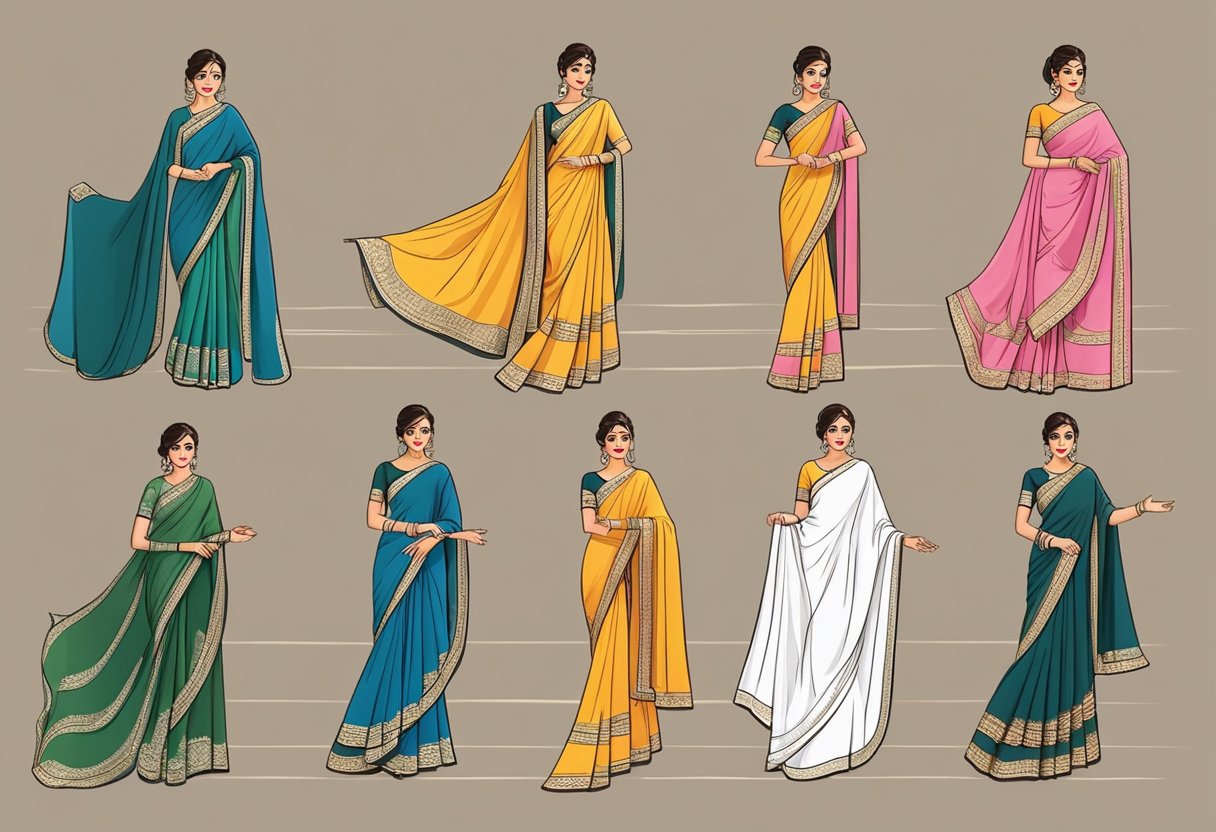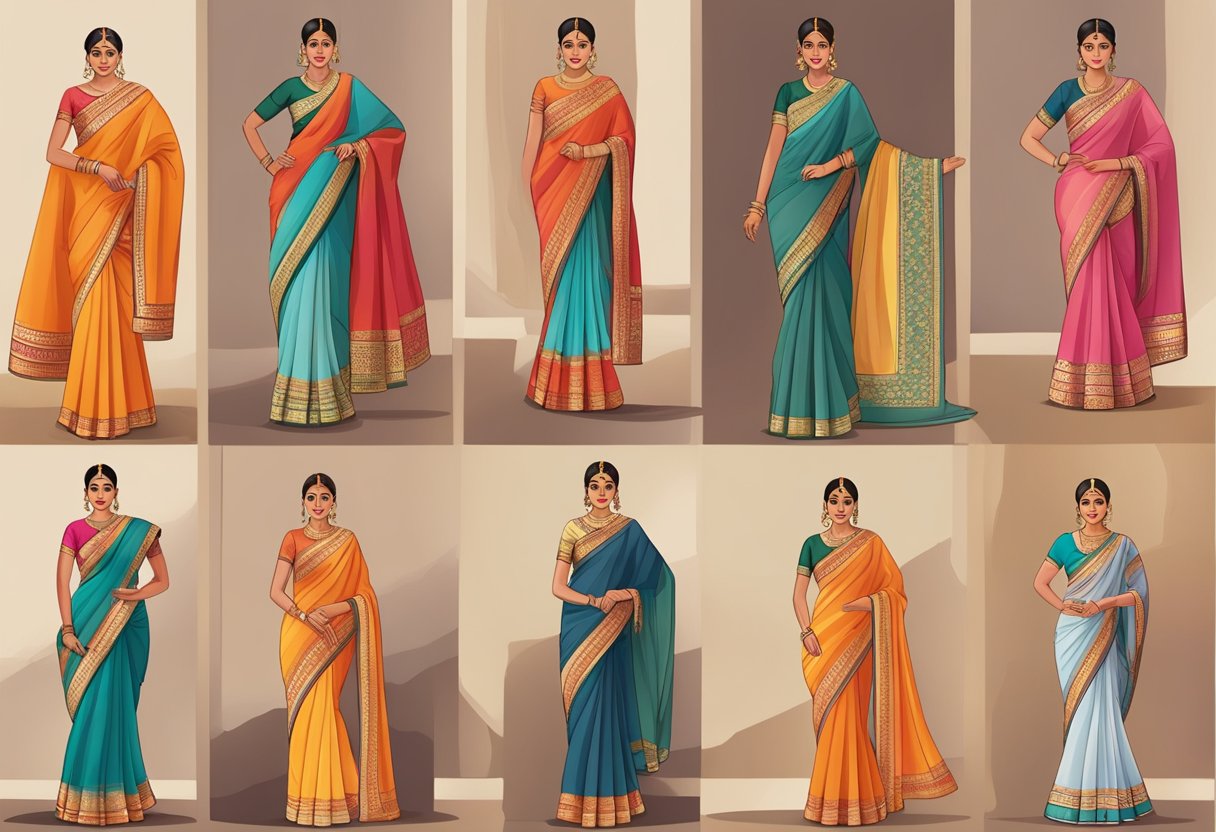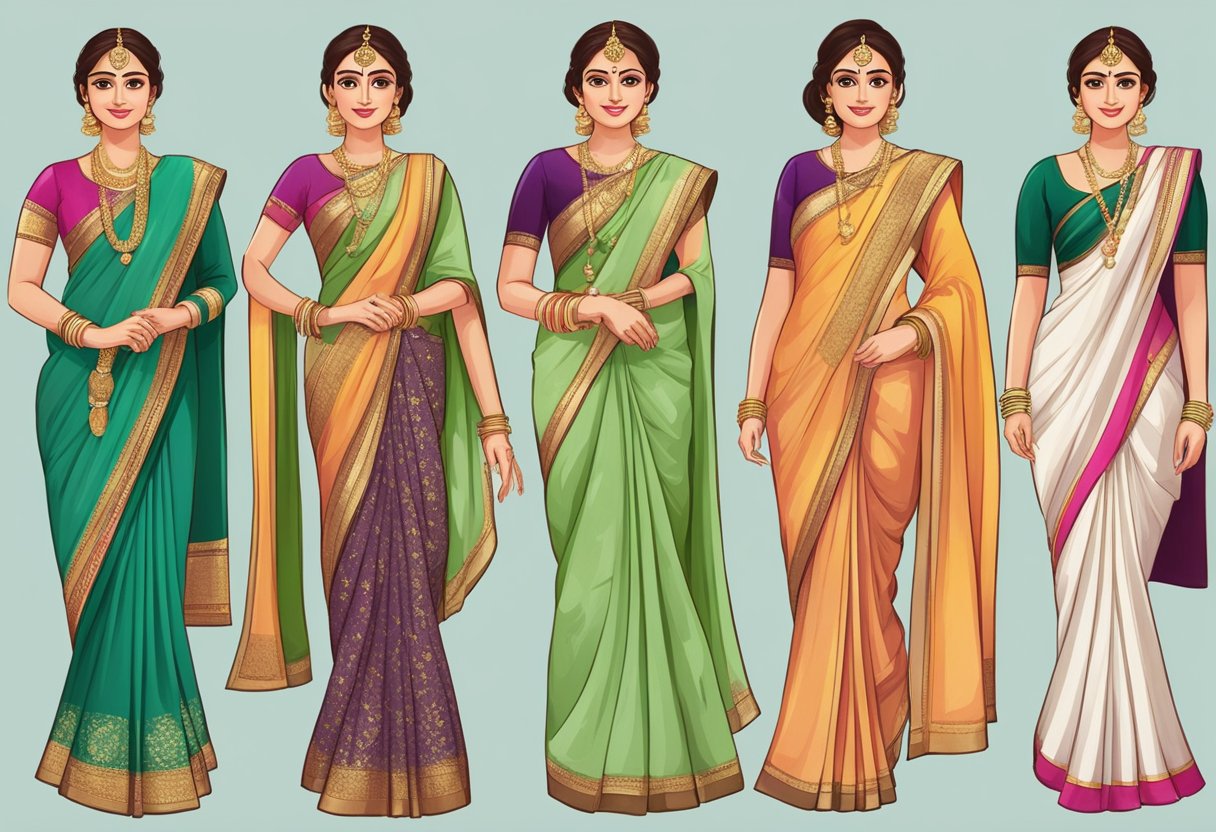Saree is a traditional Indian outfit that has been gaining popularity worldwide for its elegance and versatility. The saree is a long piece of cloth draped around the body in various styles. In this article, we will explore 5 different styles of wearing a saree that can give you a trendy and modern look.

The first style is the classic Nivi drape, which is the most common and traditional way of wearing a saree. It involves pleating the saree and tucking it into the waistband, then draping the remaining cloth over the shoulder. The second style is the Bengali drape, which is similar to the Nivi drape but with a twist. The saree is draped from the back to the front, and the pallu is draped over the left shoulder.
The third style is the Gujarati drape, which involves pleating the saree and tucking it into the waistband, then bringing the pallu from the back to the front and draping it over the right shoulder. The fourth style is the Maharashtrian drape, which involves wearing the saree in a dhoti style, with the pallu draped over the left shoulder. The fifth style is the modern drape, which is a fusion of the traditional and modern styles, giving a chic and trendy look.
Fundamentals of Saree Draping

Understanding Saree and Blouse Pairings
When it comes to wearing a saree, pairing it with the right blouse is crucial. The blouse should not only complement the saree but also fit well and be comfortable to wear. The fabric of the blouse should also be chosen carefully, as it can make or break the overall look. For instance, a heavily embellished blouse may not be suitable for a simple cotton saree.
Choosing the Right Petticoat
The petticoat is an essential part of saree draping as it provides the foundation for the saree to drape around the body. It is important to choose the right petticoat, which should match the color of the saree and be made of a comfortable fabric. The length of the petticoat should be adjusted according to the height of the person wearing it, and it should be tied securely around the waist.
Basic Pleating Techniques
Pleating the saree is a crucial step in the draping process. There are different pleating techniques, and the choice of technique depends on the style of draping. The most common technique is the basic pleat, which involves folding the saree fabric into small pleats and tucking them into the waistband of the petticoat. The pleats should be uniform in size and shape, and the number of pleats should be adjusted according to the length of the saree.
In conclusion, understanding the fundamentals of saree draping is important to achieve a flawless look. By choosing the right saree and blouse pairing, petticoat, and pleating technique, one can create a beautiful and comfortable saree drape.
Regional Saree Styles and Draping Methods

Saree, a traditional Indian attire, is worn in different styles across various states of India. Each style has its unique charm and elegance. Here are some of the popular regional saree styles and draping methods.
Gujarati Style
The Gujarati style of saree draping is known for its vibrant colors and intricate designs. The saree is draped in a way that the pallu (veil) falls over the right shoulder, and the pleats are tucked in the front. The pallu is then draped over the head and brought to the front, creating a V-shape. The saree is often paired with traditional accessories like bangles, earrings, and a nose ring.
Bengali Style
The Bengali style of saree draping is one of the most identifiable styles. The saree is draped with box pleats in the front, while the pallu appears on both shoulders. The saree is often made of silk and has a red border. The look is completed with traditional accessories like a bindi, bangles, and earrings.
Maharashtrian Style
The Maharashtrian style of saree draping is simple yet elegant. The saree is draped in a way that the pallu falls over the left shoulder, and the pleats are tucked in the back. The saree is often paired with traditional accessories like a nose ring, bangles, and a waistband.
Tamil Nadu's Kanchipuram Saree
The Kanchipuram saree is a popular silk saree from Tamil Nadu. It is known for its rich colors and intricate designs. The saree is draped in a way that the pallu falls over the left shoulder, and the pleats are tucked in the front. The saree is often paired with traditional accessories like gold jewelry and a bindi.
Kerala's Kasavu Elegance
The Kasavu saree is a traditional saree from Kerala. It is made of cotton and has a gold border. The saree is draped in a way that the pallu falls over the left shoulder, and the pleats are tucked in the back. The saree is often paired with traditional accessories like a gold necklace and earrings.
In addition to these popular regional saree styles, there are other types of sarees like Bandhani saree, Pochampally saree, Kalamkari saree, Banarasi saree, Chikankari sarees, Cotton sarees, and Sambalpuri saree, each with its unique draping method and style. The choice of saree and draping style also depends on the occasion. Silk sarees are often worn for weddings and other formal occasions, while cotton sarees are preferred for daily wear.
Overall, the regional saree styles and draping methods showcase the diversity and richness of Indian culture and tradition.
Frequently Asked Questions

What are the most popular traditional saree draping styles for weddings?
The most popular traditional saree draping styles for weddings are the Nivi style, the Bengali style, the Gujarati style, and the Maharashtrian style. The Nivi style is the most common style, and it involves draping the saree over the left shoulder and then bringing it back to the right side. The Bengali style involves draping the saree in a way that the pallu is draped over the left shoulder and the saree is tucked in at the waist. The Gujarati style involves pleating the saree in a way that it falls in front of the body, and the pallu is draped over the right shoulder. The Maharashtrian style involves draping the saree in a way that the pallu is draped over the left shoulder, and the saree is tucked in at the back.
How can one drape a saree to achieve a slimmer appearance?
One can drape a saree to achieve a slimmer appearance by opting for a saree with a lighter fabric and a smaller print. One can also choose to drape the saree in a way that it covers the midriff and creates a vertical line, which helps in creating an illusion of a slimmer appearance. Additionally, choosing a saree with a darker shade and draping it in a way that it falls straight down can also help in achieving a slimmer appearance.
Can you list the different modern ways to wear a saree?
The different modern ways to wear a saree are the pant style saree, the dhoti style saree, the lehenga style saree, the half saree style, and the saree gown style. The pant style saree involves wearing a saree with a pair of pants instead of a petticoat. The dhoti style saree involves draping the saree in a way that it resembles a dhoti. The lehenga style saree involves draping the saree in a way that it resembles a lehenga. The half saree style involves wearing a saree in a way that it resembles a half saree. The saree gown style involves wearing a saree in the form of a gown.
What are some unique saree styles for a reception event?
Some unique saree styles for a reception event are the butterfly style, the mermaid style, the cape style, and the jacket style. The butterfly style involves draping the saree in a way that it resembles a butterfly. The mermaid style involves draping the saree in a way that it resembles a mermaid tail. The cape style involves wearing a cape over the saree. The jacket style involves wearing a jacket over the saree.
How many recognized traditional saree draping methods exist in India?
There are more than 80 recognized traditional saree draping methods in India. Each state in India has its own unique way of draping the saree, and the draping style varies based on the occasion and the cultural significance.
What are the names of different saree draping styles?
The names of different saree draping styles are the Nivi style, the Bengali style, the Gujarati style, the Maharashtrian style, the Tamilian style, and the modern fusion style. The Nivi style is the most common style, and it involves draping the saree over the left shoulder and then bringing it back to the right side. The Bengali style involves draping the saree in a way that the pallu is draped over the left shoulder and the saree is tucked in at the waist. The Gujarati style involves pleating the saree in a way that it falls in front of the body, and the pallu is draped over the right shoulder. The Maharashtrian style involves draping the saree in a way that the pallu is draped over the left shoulder, and the saree is tucked in at the back. The Tamilian style involves draping the saree in a way that it covers the head, and the pallu is draped over the left shoulder. The modern fusion style involves combining traditional saree draping styles with modern elements.

